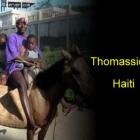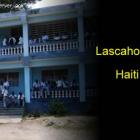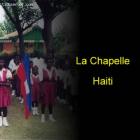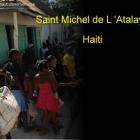ADVERTISEMENT
City - Haiti Observer Blog
City, Haiti Observer Blog. Read the following articles about City
Acul-du-Nord in Nord Department of Haiti
In the country's northern part lies the Nord Department, which is made up of Acul-du-Nord Arrondissement that is composed of three municipalities, namely Acul-du-Nord, Plaine-du-Nord and Milot. The department is home to more than 100,000 Haitians.
The municipality of Acul-du-Nord, often referred to as Akil dinò in Creole. It is divided into six small towns: Bas de l'Acul, Camp Louise, Coupe a David, Grande Ravine, La Soufriere, and Mornet.
Acul-du-Nord is the home of 51,337 Haitians who concentrate on agriculture as their main source of livelihood. The common produce in the municipality are coffee, different kinds of fruits, and rice. Haitians in this region also practice beekeeping for attaining honey and selling this in the local market and in foreign trade. Majority of Acul-du-Nord's population are Roman Catholics due to the introduction of Christianity in the 1600s by Haiti's European colonizers. One of the earliest marks of Christianity in the municipality is the Camp Louise Parish located in the town of Camp Louise, which was built and completed in 1699 by the colony's former governor, Saint Domingue.
Town of Dame-Marie
Dame-Marie is located in a small town on the seaside on Haiti's western tip in the Anse-d'Hainault municipality. It lies on the western side of the meridian at 74° 25'0" and towards the north of the equator at 18° 34' 0" with an elevation of 114 meters above the level of the sea.
Development in Dame-Marie
The Port au Prince is located at a 219 kilometers distance. On the Caribbean Sea edge, is located Dame-Marie town, filled with crags. As per the 2003 census, it has a population of around 271127.
Here is where you can find some beautiful pictures about Dame-Marie
Casal with its Polish influence
Casal is a small Haitian city located in the North American region and has a very small population. Port-au-Prince, Carrefour and Guantanamo are the major cities that can be found close to Casal. Casal has a significant Polish influence and many people are baffled by the fact that Poland and Casal are not close to each other and yet, Casal has a huge Polish influence. This revolution can however be traced back to the era of Haitian Revolution.
It was during 1802 when Napoleon arrived with his army at Saint Domingue to take care of the slave rebellion. The army consisted of Polish legion. Napoleon dispatched 5200 Polish soldiers for Saint Domingue to suppress the revolt. Upon arrival, these Polish soldiers found that it was not the rebellion mentioned by Napoleon but was actually a slave revolt in which the slaves were fighting for their freedom.
Bellevue la Montagne in Haiti
Bellevue la Montagne is located in region Ouest, Haiti. It is a small place with a very small population that survives under inexplicable poverty. People in Bellevue la Montagne are live examples of what we say, 'life goes on and you just live.' Yes, they just live! La Montagne means 'The Mountain' in French. This explains the geographic location of Bellevue la Montagne which stands at 3000 feet elevation from the coast.
Bellevue la Montagne consists of 3 small villages which include Belleu, Terra Rouge and Le Croix. Living in ultimate poverty, the main livelihood for the people of Bellevue la Montagne is farming. Because of shortage of electricity, water and irrigation facilities, agriculture produces just enough for the farmers to feed their families and if they are lucky, they will have some extra produce that they can sell in local market. There is only one school in Bellevue la Montagne that is located at a distance of 1-1/2 hours and children need to spend 3 hours every day to walking up and down to their school. Only those children go to school whose parents can afford $25 a year.
Read about more Haitian cities and towns....
Jalousie Slum Makeover, Beauty Versus Poverty in Color
A psychedelic makeover of Jalousie slum in Haiti is under progress. This uninviting concrete block of homes lay on mountainside of the capital of Haiti. The makeover of this largest shantytown of Haiti covers two aspects - homage and art. The facades are being painted by workers in cream, lime, peach and purple. The inspiration for these colors comes from Prefete Duffaut's work "Cities-in-the-skies". Duffaut was a great Haitian painter who died in 2012.
The whole effort is given a name - 'Beauty versus Poverty: Jalousie in Colors'. The project will cost $1.4 million and this slum makeover is an attempt of government to relocate the people living in displacement camps that were a result of 2010 earthquake. The government plans to pick up some high-profile camps in the nation's capital and relocate them in places like Jalousie while paying rent for a whole year in form of subsidies for those residents. The government also plans in tidying up these areas by providing city services and aims towards building up a place that will be decent for living and people will be proud to be a part of the place.
Arniquet Community in Haiti
Arniquet is a cityship located in the Port-Salut Arrondissement, under the Sud Department. With an estimated population of 8,000, it lies 583 feet above sea level. Located on the south-western part of the Tiburon Peninsula, it faces the Caribbean Sea. In its time zone, the sun in Arniquet shines nearly 12 hours a day, from 6:30 am to 6:00 pm.
Like most small villages across Haiti, Arniquet has no paved roads, no air strip, and electricity is infrequently delivered. Because of this undependable service, the villagers retire when the sun sets and get up when the sun rises.
Port-au-Prince: Haiti's Capital
Being the country's capital, Port-au-Prince has a lot to offer. It is the main commercial district in the country, as businesses thrive in the city. It has a population of more than 1.2 million, most of whom are Africans but many businesses are owned by people with various races.
As the national capital, Port-au-Prince is the center of the country's economy. It is one of the leading exporters of coffee and sugar. It also used to export baseballs, shoes and other goods. Many food-processing plants and factories of soap, cement and textile, as well as construction companies can be found in Port-au-Prince. Tourism used to have a lot of potential, as the capital was once a popular destination for cruises. However, political unrest, higher crime rate and other factors made it a little less attractive to tourists, leading to a huge drop in tourism. Currently, there are no more cruise ships coming to the city's ports.
Fonds-des-Negres and its Infrastructure
In the southern section of Haiti lies the cityship of Fonds-des-Nègres, which straddles both Miragoâne and Nippe Departments. The city, founded in 2003, was born of the capital city of Miragoâne. Three other communes make up Miragoâne: Bouzi, Pemerle, and Cocoyers-Duchene.
Roads in Fonds-des-Nègres are in very bad shape, many of them dirt roads. At this time, however, road-work projects are proceeding, the roads now being built and repaired to bring them up-to-date with current safety codes. In areas where heavy rains block passage of traffic because of spontaneous lakes created by the deluges, bridges are going up as well.
Anse-d'Hainault in Haiti
Anse-d'Hainault, a cityship part of the Anse-d'Hainault Arrondissement and a third-tier directorate department in the Grand'Anse area, is located on the western tip of Haiti's peninsula. The city has a low-density population of 23,185 residents, and a low-humidity tropical climate. Its mineral-rich soil contains clay deposits, and its terrain is studded with farmlands and indigenous vegetation. As elsewhere in Haiti, Anse-d'Hainault is a predominately Catholic community.
When the 7.0 magnitude 2010 earthquake shook Port-au-Prince and other regions in the country to their foundations, emotional shock waves reverberated throughout the world. In the aftermath of the cataclysmic event, no place has had a stronger response and made a fuller commitment to Haiti than Holy Trinity Catholic Church (HTCC).
The Town of Mirebalais, Haiti
There is no stopping Haiti's town of Mirebalais from developing into a significant municipality in the Mirebalais Arrondissement. The town is currently seeing various developmental projects that can surely improve the lives of the 165,000 people living there. The Arrondisement capital, which is only 30 miles and a 45-minute drive from Port-au-Prince, has become a place for people seeking a less populated town with many employment opportunities. With the developmental projects launched in the town, people are able to get jobs.
One of things that Mirebalais is proud of is the establishment of a modern teaching hospital, which is expected to be completed next year. It can be recalled that in 2010, non-government organizations Partners in Health and Zanmi Lasante rolled out a plan to build a state-of-the-art community hospital in the town. The construction, however, was hampered by the 2010 earthquake. Construction resumed and will likely finish in 2013. The Mirebalais National Teaching Hospital, the first of its kind, will be able accommodate about 320 in-patients. It will also feature training facilities for medical students, nurses and physicians. This is a good thing as Haiti is in need of more medical professionals in order to enhance health services.
Our objective is to share with you news and information about Haiti and the people of Haiti. Traditions, habits and the way we were or grew are alive in this site. We highly recommend that you Subscribe to our Newsletter and also share with us some of the things that are memorable and made us unique people.

 Thomassique, Haiti
Thomassique, Haiti  Lascahobas, Haiti
Lascahobas, Haiti  La Chapelle, Haiti
La Chapelle, Haiti  Saint Michel de L 'Atalaye
Saint Michel de L 'Atalaye  Life After Death
Life After Death